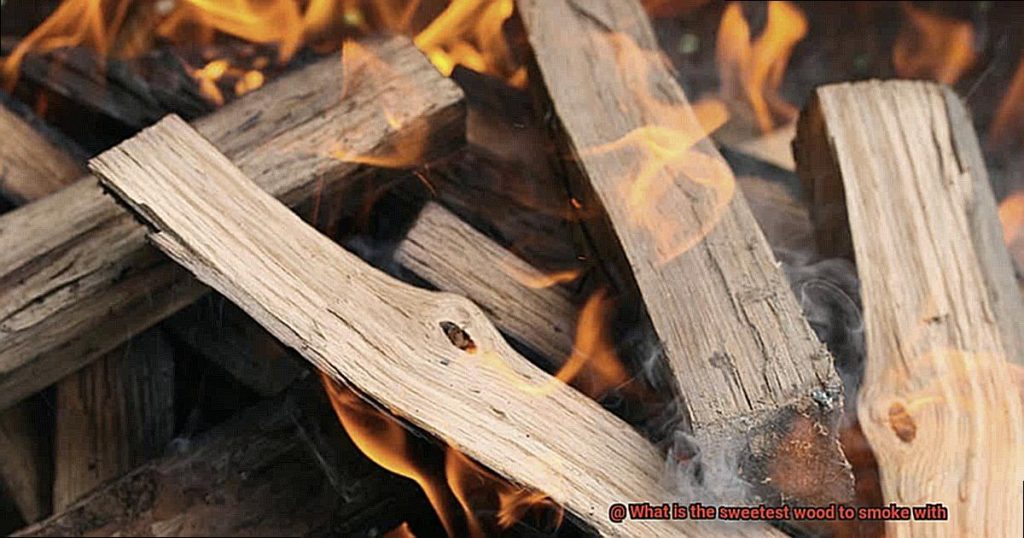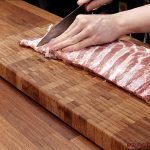Picture this: the sizzle of meat on a hot grill, the smoky aroma filling the air, and the anticipation of that first bite. Cooking over a wood fire is an experience like no other. But if you want to take your outdoor cooking game to the next level, choosing the right wood is crucial. So, what’s the sweetest wood to smoke with?
Well, it all depends on your personal taste and what you’re cooking. But if you’re after a deliciously sweet and succulent flavor, there are a few options that stand out from the crowd. Fruit woods like apple, cherry, and pear are popular choices thanks to their mild yet sweet flavor. Meanwhile, hickory and maple offer a slightly nutty taste that’s just as tempting.
But hold up – don’t forget about mesquite and oak. These woods pack a punch with their robust flavors that can take your dish to new heights. Just be careful not to go overboard as they have a distinctive taste that may overpower your food.
Of course, using quality wood is key to achieving mouth-watering results. Make sure you choose properly seasoned wood as green or unseasoned wood can leave behind an unpleasant bitter taste.
So whether you’re smoking ribs or grilling chicken wings, now you know which woods will give you that sweet edge in flavor. So why wait? Get your smoker ready and let’s fire up some tasty eats.
Contents
What is the Sweetest Wood to Smoke With?
The type of wood you choose to smoke with can make all the difference in the world. It’s no wonder that grill enthusiasts often ask, “What is the sweetest wood to smoke with?” The answer to this question is not cut and dried, as it depends on personal preference and the type of meat or fish you’re smoking.
One of the sweetest woods for smoking is fruitwood. Apple, cherry, and peach all produce a mild and sweet flavor profile that pairs well with pork, chicken, and fish. These woods provide a subtle sweetness that enhances the natural flavors of the meat. Applewood is a standout favorite among grill enthusiasts for its versatility and gentle smoky flavor. It enhances the sweetness of fruits like apples and pears, making it a popular choice for smoking pork chops, baby back ribs, and chicken.
Maplewood is another sweet wood option to consider. With its unique blend of sweetness and smokiness, it’s perfect for smoking meats like ham or bacon. Maple wood adds a rich sweetness that complements the saltiness of cured meats. It also works well with beef, providing a sweet and nutty flavor profile that enhances the natural flavors of the meat.
For those who prefer a stronger smoky flavor, hickory wood is an excellent choice. It has a bold and robust flavor profile that pairs well with meats like brisket and pork shoulder. While it’s not as sweet as fruitwoods or maple, hickory wood adds a depth of flavor that can’t be achieved with milder woods. Mesquite wood is another strong option for adding smoky flavor to beef and game meats.
It’s important to note that while sweet woods can add delicious flavor to your meats, they can also overpower the natural taste if used too heavily. To achieve the perfect balance of flavors, it’s best to start with a small amount of wood and gradually increase as needed. Another way to ensure the perfect balance is to use a combination of woods, such as mixing fruitwood with hickory for a sweet and smoky flavor profile.
Fruitwoods: The Sweetest Woods for Smoking
As a connoisseur of smoked meats, I can confidently say that fruitwoods are the ultimate secret ingredient to elevate your grilling game. These sweet woods impart a delicate fruity aroma and flavor to your food, making them stand out from the crowd. But what makes fruitwoods so special? Allow me to break it down for you.
First and foremost, fruitwoods burn hotter and faster than other hardwoods, which makes them ideal for grilling and smoking. This means you’ll get that perfect sear on your steak or juicy tenderness on your chicken in no time. Plus, fruitwoods offer various flavors that pair well with different types of meat.
Let’s take a closer look at some of the popular fruitwoods used for smoking:
- Applewood: This is one of the most commonly used fruitwoods, known for its mild and sweet flavor. It pairs perfectly with pork, poultry, and seafood, and it’s an excellent choice for beginners who want to experiment with different flavors.
- Cherrywood: If you’re a fan of beef, lamb, or game meats, then cherrywood is the way to go. It has a slightly sweet taste with a hint of tartness that adds depth to your dish. Plus, it gives off a beautiful reddish hue that will make your meat look impressive.
- Peachwood: For a subtle sweetness to your meat, go for peachwood. It’s perfect for smoking salmon or trout but also goes well with pork or chicken. It gives off a delicate aroma that will make your mouth water.
- Pearwood: This wood has a mild flavor that complements poultry, pork, and vegetables. It’s perfect if you want to add a touch of sweetness without overpowering the natural flavors of your dish.
- Plum wood: Last but not least, plum wood has a sweet and floral aroma that goes well with chicken and fish. It’s an excellent choice if you want to impress your guests with a unique flavor profile.
When using fruitwoods for smoking, it’s crucial to ensure that the wood is properly seasoned and dried before use. Green or unseasoned wood can produce bitter flavors that ruin the taste of your food. Additionally, fruitwoods burn quickly, so it’s recommended to use them in combination with other hardwoods like oak or hickory to maintain a steady temperature during the smoking process.
Maplewood: A Subtle Sweetness
Maplewood is a versatile wood that can be used for almost any type of meat. Its mild and sweet flavor complements the natural flavors of the meat without overpowering them. But, before you start smoking with maplewood, it’s essential to use only dried or seasoned wood. Green or freshly cut maplewood will produce a bitter taste and ruin the flavor of your meat.
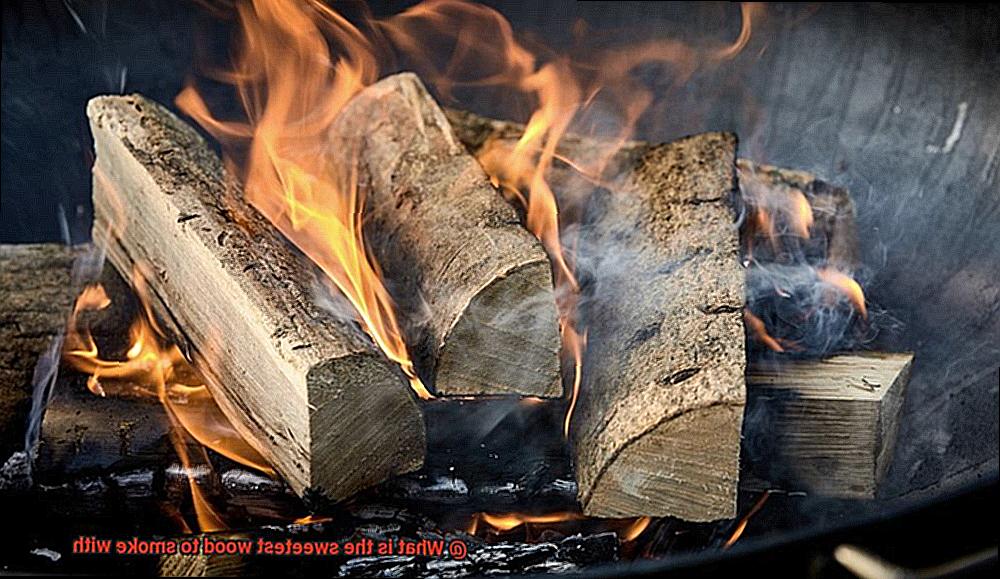
For best results, soak your wood for at least 30 minutes before using it for smoking. This prevents the wood from burning too quickly and producing excessive smoke. One of the benefits of using maplewood is that it produces a consistent smoke level throughout the cooking process. Unlike some other woods that may produce a strong smoke at the beginning and then taper off, maplewood provides a steady smoke that helps to infuse the meat with flavor throughout the entire cooking time.
If you’re feeling adventurous, try mixing maplewood with other woods like hickory or applewood for added depth of flavor. The combination of different woods adds complexity to your BBQ dishes and enhances their taste. In fact, maplewood is an excellent choice when making bacon or ham as it adds a touch of sweetness to these cured meats.
Hickory and Mesquite Woods: For a Smokier Flavor
If you’re looking to elevate your grilling game and add a smoky flavor to your dishes, then look no further than hickory and mesquite woods. These two types of wood are the most popular choices for smoking and can take your BBQ dishes to the next level.
Let’s dive into hickory wood first. This hardwood is a favorite for smoking pork, beef, and poultry due to its strong and bold flavor. It has a slightly sweet taste with a hint of smokiness that can enhance the natural flavors of your meats. You can use hickory wood alone or in combination with other woods like applewood or cherry wood to create a unique and complex flavor profile.
Mesquite wood, on the other hand, has a much stronger and sweeter flavor than hickory. This hardwood is commonly used for smoking beef, poultry, and game meats. It burns hot and fast, but its intense flavor makes it a great option for those who love a smokier taste. To control the intensity of the smoke, mesquite wood is often used in combination with other woods.
It’s important to remember that both hickory and mesquite woods can overpower the natural flavors of your meats if used too heavily. So, it’s crucial to use them in moderation to find the perfect balance that suits your taste preferences.
To summarize, hickory and mesquite woods are excellent choices for adding a smoky flavor to your grilled dishes. Here are some tips to help you make the most out of these woods:
- Use hickory wood for pork, beef, and poultry.
- Use mesquite wood for beef, poultry, and game meats.
- Experiment with different combinations of woods to create unique flavor profiles.
- Use these woods in moderation to avoid overpowering the natural flavors of your meats.
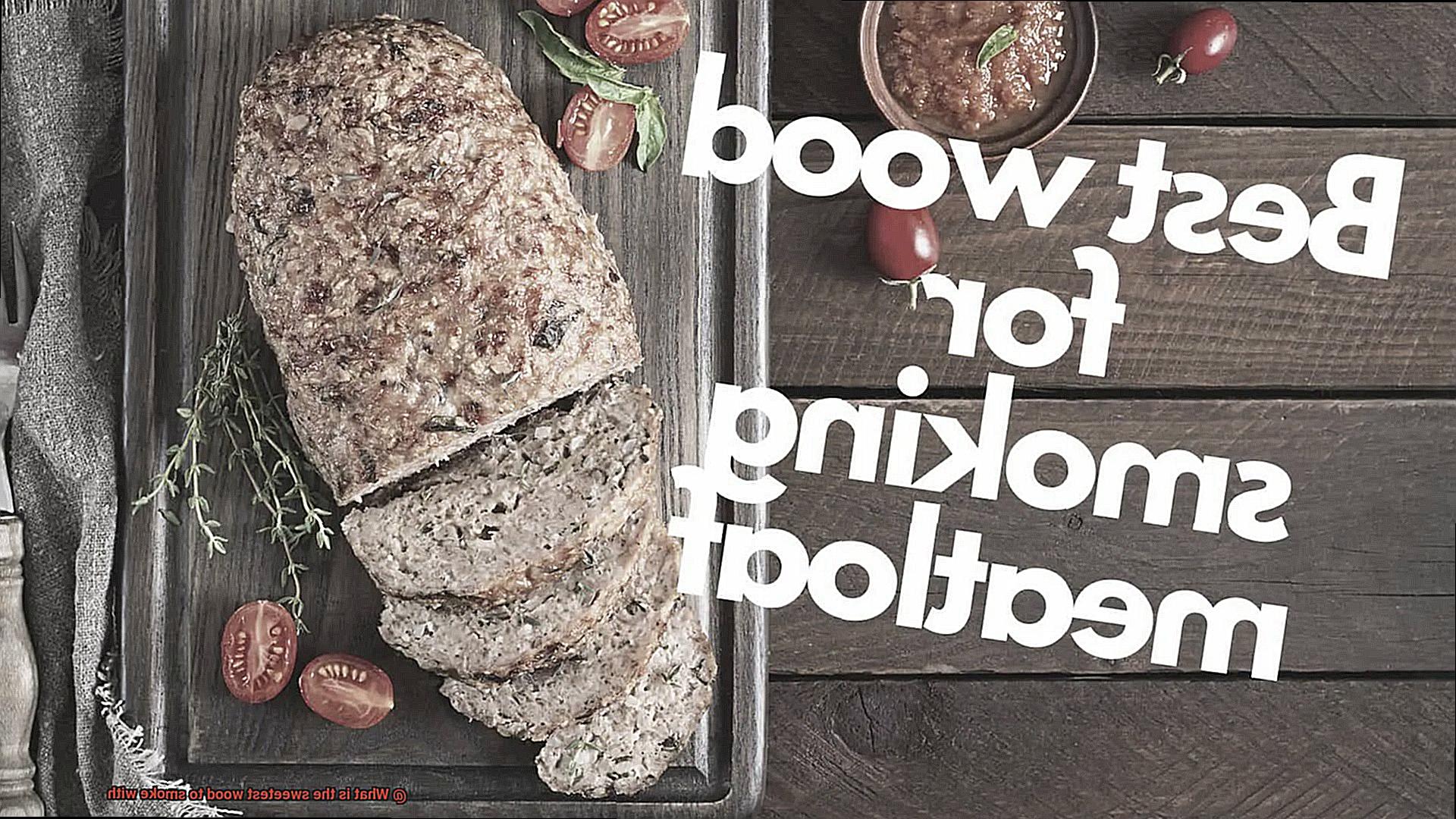
How to Use Sweet Woods in Smoking
Smoking meat is an art that requires patience, practice, and the right tools. One of the most important tools in a smoker’s arsenal is sweet woods. These woods have a naturally sweet flavor that can enhance the taste of your meat and add a unique touch to your dish. Here are five sub-sections to help you master the art of using sweet woods in smoking.
Choose the Right Sweet Wood
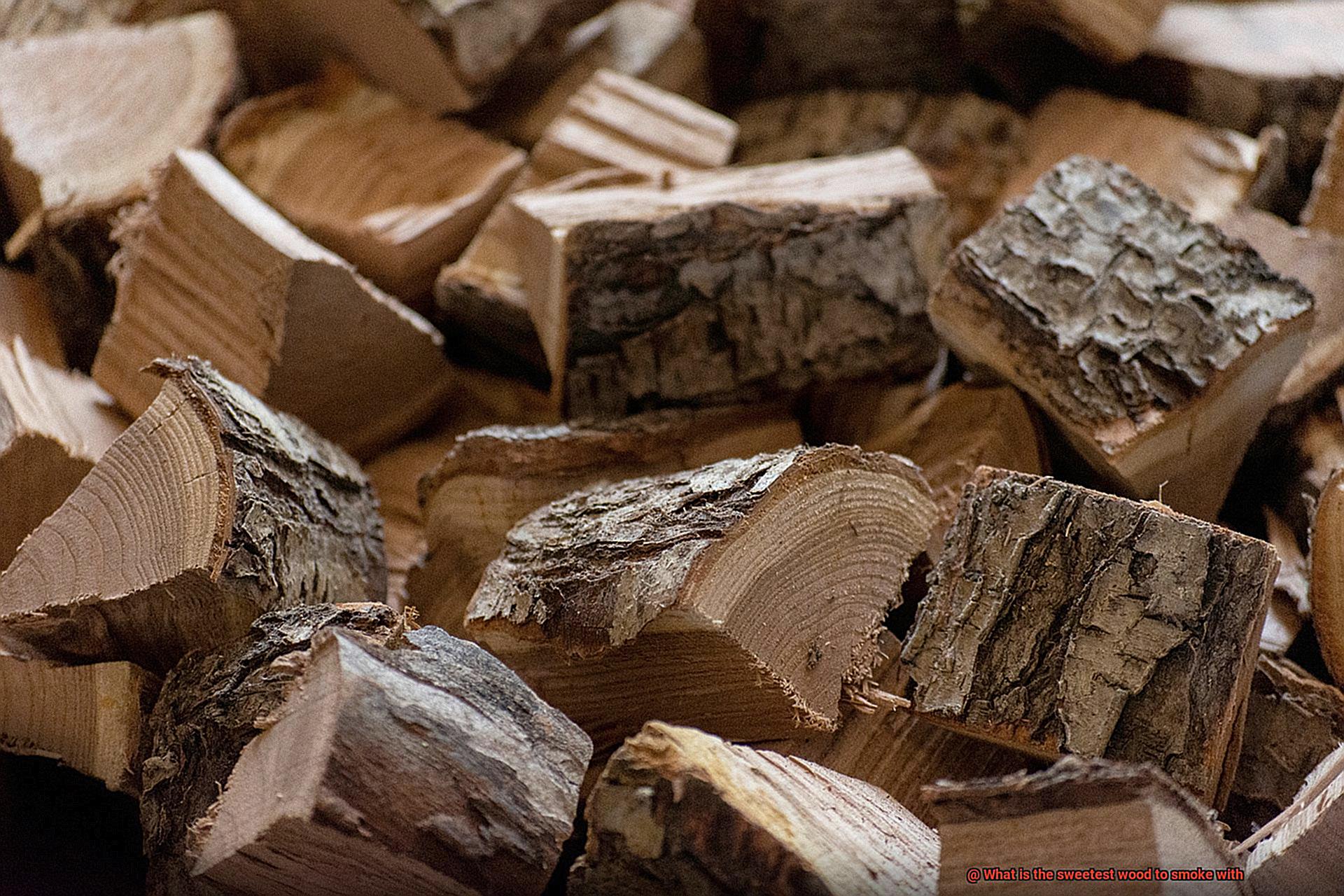
The first step to using sweet woods in smoking is to select the right wood for your meat. Each wood produces a different flavor profile, so it’s essential to choose one that complements your meat. Fruitwoods like cherry and apple are great for pork and poultry, while nutwoods like pecan and hickory pair well with beef and lamb. Choose the right wood, and you’ll be off to a good start.
Soak Your Wood
Before using sweet woods in smoking, it’s crucial to soak them in water for at least 30 minutes. This will prevent the wood from burning too quickly and producing harsh smoke that can ruin your meat’s flavor. Soaking also helps the wood produce a more consistent smoke that will infuse your meat with its distinct flavor.
Regulate Temperature and Airflow
To achieve the perfect smoky flavor, regulate the temperature and airflow in your smoker or grill. This ensures that the sweet wood produces an even smoke throughout the cooking process, enhancing the taste of your meat. Keep an eye on your meat and add more wood as needed to maintain a consistent flavor.
Don’t Overdo It
While sweet woods can add a delicious flavor to your meat, they can also overpower it if used too heavily. Start with a small amount of wood and gradually increase as needed to achieve your desired flavor. Remember that less is more when it comes to using sweet woods in smoking.
Experiment with Different Sweet Woods
There is no one-size-fits-all approach to using sweet woods in smoking. Experiment with different woods to find the perfect flavor combination for your meat. Try mixing different woods or using a blend of sweet and savory woods to create a unique flavor profile that will make your dish stand out.
Tips for Choosing the Right Wood for Your Meat
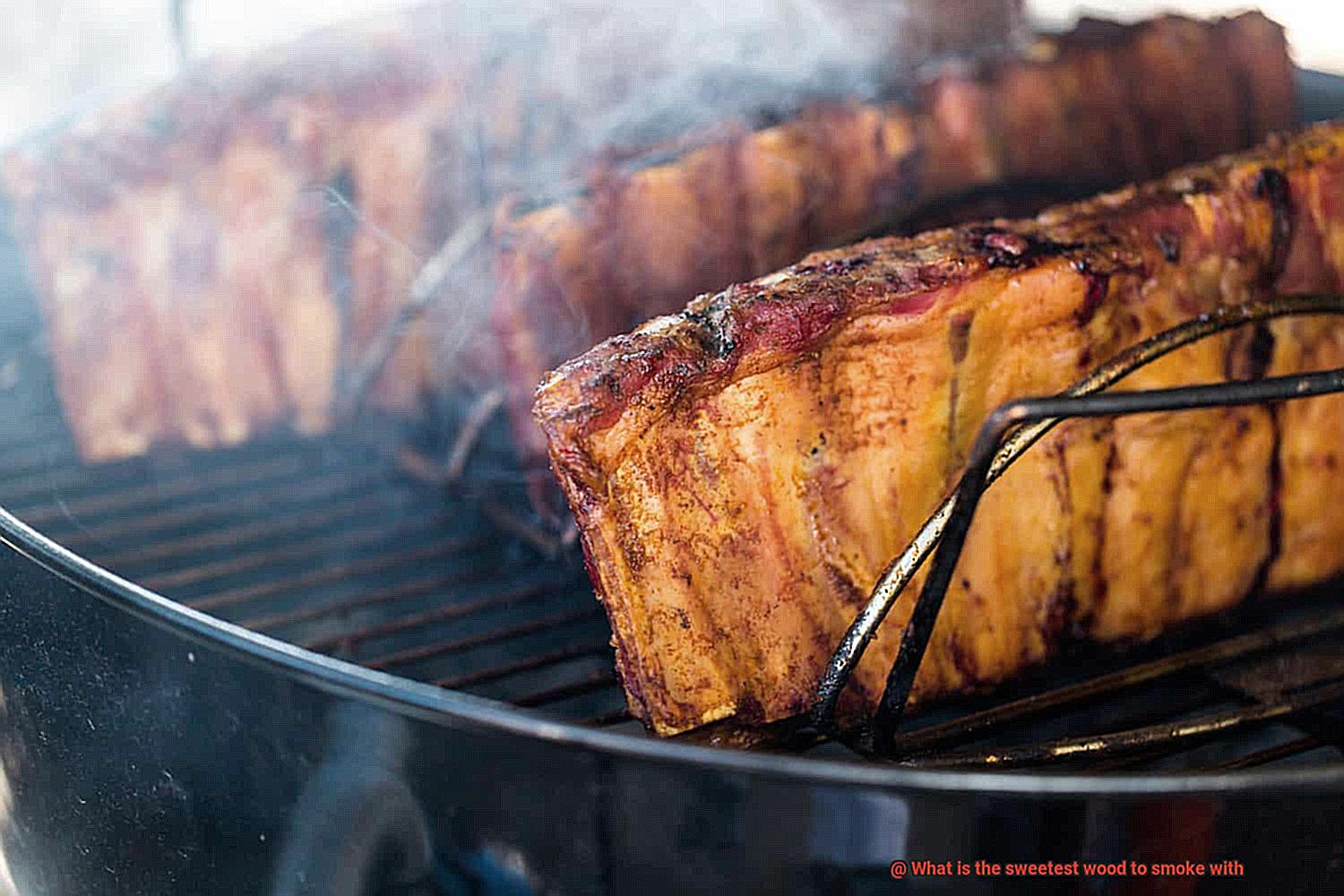
Smoking meat is an ancient practice that has been perfected over time, and one of the critical factors that determine its outcome is the type of wood used. The right wood can make all the difference in achieving a unique flavor profile that tantalizes your taste buds. Below are five tips to help you choose the perfect wood for your smoked meat:
Consider the type of meat you’re smoking
Different types of meat have different flavors, and pairing them with the right wood enhances their natural taste. For example, chicken and turkey go well with fruitwoods like apple or cherry, while beef and lamb pair better with hardwoods like hickory or oak.
Think about the flavor profile you want to achieve
The type of wood used determines the flavor profile of your smoked meat. If you’re looking for a sweet taste, go for fruitwoods like maple or pecan. On the other hand, if you want a bold and smoky flavor, use hardwoods like mesquite or hickory.
Use high-quality wood
Using high-quality wood is essential to prevent harmful chemicals from ruining your smoked meat’s flavor. Opt for wood that’s specifically labeled for smoking and free from pesticides and chemicals.
Soak wood chips before use
Soaking your wood chips in water before use helps prevent them from burning too quickly and producing a bitter taste. It also adds moisture to the smoking process, resulting in a tender and juicy final product.
Mix hardwoods and fruitwoods
Combining hardwoods and fruitwoods provides a balanced flavor profile that enhances the natural taste of the meat. Hardwoods provide a robust base flavor, while fruitwoods add sweetness and a fruity aroma.
Different Types of Meats and Their Best Matching Woods
Smoking meats is an art form that requires the right ingredients and techniques to produce the perfect flavor. One of the most important ingredients in smoking meats is the wood used in the process. The type of wood you use can make or break your dish, so it’s important to choose wisely. Here are five sub-sections exploring the best matching woods for different types of meats.
Beef
If you’re smoking beef, hickory and oak are great choices for creating a bold and smoky flavor. These woods pair perfectly with the richness of beef, making them a popular choice for brisket and ribs. Mesquite wood is another popular option, but should be used sparingly as it can easily overpower the flavor of the meat.
Pork
Fruitwoods like apple and cherry are popular choices for smoking pork as they add a sweet and tangy flavor that complements the natural sweetness of the meat. Hickory and oak can also be used for a bolder taste. These woods are great for smoking pork shoulder or ribs.
Poultry
When it comes to smoking chicken or turkey, milder woods like alder or maple are ideal as they add a subtle smoky flavor without overpowering the delicate flavors of the meat. Pecan wood is another popular option for poultry, adding a slightly sweet and nutty flavor to the meat.
Fish
Fish and seafood require lighter woods like alder or cedar as they provide a delicate smoky flavor without overpowering the natural taste of the seafood. Cedarwood is a classic choice for smoking fish, adding a subtle smokiness that pairs well with seafood’s natural flavors.
Game meats
For game meats like venison or elk, mesquite wood is a popular choice for adding a distinct smoky flavor that pairs well with these rich meats. However, if you prefer a milder smoky flavor, fruitwoods like cherry or apple can also be used.
He-Nw5-LMrE” >
Conclusion
In conclusion, selecting the right wood for smoking is essential to achieving delectable results. While there’s no one-size-fits-all approach, some options stand out from the rest. Fruitwoods like apple, cherry, and pear provide a mild yet sweet flavor that enhances pork, chicken, and fish’s natural flavors. Meanwhile, hickory and maple offer a slightly nutty taste that’s just as tempting. Mesquite and oak pack a punch with their robust flavors that can take your dish to new heights.
When using sweet woods in smoking, it’s crucial to ensure they are properly seasoned and dried before use. Green or unseasoned wood can leave behind an unpleasant bitter taste. Regulating temperature and airflow in your smoker or grill is also critical to achieving the perfect smoky flavor.
Less is more when using sweet woods in smoking, as they can overpower the meat’s natural flavors if used too heavily. Experimenting with different wood combinations can create unique flavor profiles that will make your dish stand out.
Overall, whether you’re smoking beef, pork, poultry, fish or game meats, there’s a perfect matching wood for each type of meat that will elevate your grilling game and impress your guests with succulent flavors.

